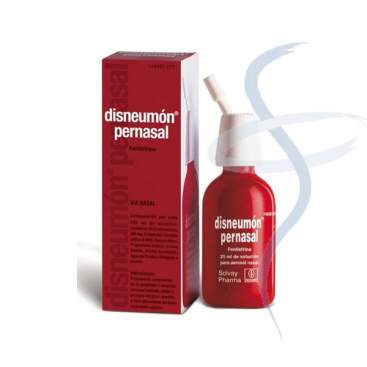Disneumon Pernasal 5 Mg/Ml Nebulizador Nasal 25 Ml
Symptomatic treatment of nasal congestion and discharge due to common cold or allergic processes, sinusitis or other alterations of the upper respiratory tract.
Symptomatic treatment of nasal congestion and discharge due to common cold or allergic processes, sinusitis or other alterations of the upper respiratory tract.
Disneumon Pernasal 5 Mg / Ml Nasal Nebulizer 25 Ml
ACTION AND MECHANISM
- [NASO / FARINGEO DESCONGESTIONANT], [ADRENERGIC AGONIST (ALFA-1)]. Phenylephrine is the physiological stereoisomer of ephedrine. After topical administration on the nasal mucosa, it acts directly on alpha-1 receptors, leading to vasoconstriction of the arterioles, decreasing the blood content and swelling of the mucosa, which produces a decongestant effect of the nasal passages. It also reduces nasal secretions, promotes sinus drainage and produces the opening of the eustachian tubes.
Phenylephrine behaves slightly as an indirect adrenergic agonist, stimulating the release of norepinephrine from its vesicles, which enhances the adrenergic effects.
The vasoconstrictive effects of phenylephrine administered by the topical nasal route are faster and more potent, although less durable. However, the occurrence of rebound congestion is more frequent.
PHARMACKINETICS
Nasal route:
- Absorption: After topical administration, vasoconstrictor effects appear immediately, and may be prolonged for 0.5-4 hours. It can be absorbed after administration in the nasal mucosa, giving rise to systemic effects, especially in case of intake, after prolonged use or with high doses.
INDICATIONS
- [NASAL CONGESTION]. Temporal and symptomatic relief of nasal congestion associated with [RINITIS], [COMMON COLD], [FLU] or [SINUSITIS].
POSOLOGY
DOSAGE:
- Adults, nasal: 1-2 sprays / 8-24 hours.
- Children, nasal:
* Children 12 years or older: 1-2 sprays / 8-24 hours.
* Children under 12 years: Safety and efficacy have not been evaluated.
The doses of this medicine should be separated at least for periods longer than 4-6 hours. It is recommended to avoid treatments longer than 3 days in a row to avoid the appearance of rebound congestion, which is usually translated by the patient as an absence of effects, which entails a new administration, with the risk of overdose.
Missed dose: In those patients who follow a dosage schedule, in case of forgetting the administration of a dose, it will be applied immediately if it is remembered within one hour. In case of remembering later, it is preferable to skip the dose, and never double it in the next administration.
RULES FOR THE CORRECT ADMINISTRATION
Before each administration, it is necessary to clean the nostrils. Subsequently, the container valve will be inserted into the nostrils, in an upright position. Actuate the valve, simultaneously taking a deep breath to facilitate maximum medication penetration. Each press must be brief, that is, the essential time to press fully and then release.
Once the medicine is administered, the end of the valve will be cleaned with hot water, then dried with a clean cloth.
In the event that the patient experiences insomnia, it is recommended to avoid the administration of phenylephrine before bedtime.
CONTRAINDICATIONS
- Hypersensitivity to any component of the medication.
- [CARDIOPATIA] severe or [DIABETES] uncontrolled.
- Patients in treatments with antidepressants of the MAOI type within 14 days before starting phenylephrine therapy (See Interactions).
PRECAUTIONS
- Patients in whom sympathetic stimulation could worsen their pathologies, such as those with [DIABETES], [GLAUCOMA], [CARDIOPATIA] ([CORONARY INSUFFICIENCY], [ISCHEMICAL CARDIOPATIA]), [CARDIAC ARRITHMIA], [ARTERIAL HYPERTENSION], [HYPERTIROIDISM], [FEOCROMOCITOMA] or [PROSTATIC HYPERPLASIA].
Phenylephrine administered by the nasal route does not usually present a risk for these patients, but due to the misuse of products with phenylephrine and its abuse, there could be a systemic absorption, which could aggravate these conditions. In case of decompensated diabetes or severe heart disease, it may be advisable to avoid the administration of phenylephrine (See Contraindications).
- Bounce congestion. The administration of topical vasoconstrictors often results in rebound congestion, which is usually accompanied by a new dosage by the patient. This may pose a risk of overdose, as well as a potentiation of congestion. It is recommended to gradually suspend the administration of phenylephrine in case of rebound congestion, alternating the doses in each nostril, until a definitive suppression.
PATIENT ADVICE
- The nose should be cleaned before each application, and then administered with the vertical head, taking a deep breath.
- Proper nasal and applicator hygiene is advisable.
- It is recommended not to exceed the recommended daily doses or use for more than three days in a row to avoid rebound congestion.
- Treatment should be discontinued and see a doctor if symptoms persist, worsen or if high fever, dizziness, insomnia or nervousness appear.
- The doctor or pharmacist should be notified if the patient has diabetes, heart disease, hypertension or glaucoma, as well as if he is being treated with any other drug.
- It is recommended to suspend treatment at least 24 hours before a surgical intervention.
- It is common the appearance of a sensation of itching or nasal discomfort after application, which disappears after several doses.
SPECIAL WARNINGS
- It is recommended to periodically monitor blood pressure in hypertensive patients and blood glucose in diabetic patients.
- It is advisable to distance the intake of MAOI and phenylephrine for at least 14 days.
INTERACTIONS
It is not expected that phenylephrine administered by the nasal route can lead to drug interactions. However, due to the frequent misuse of nasal preparations with phenylephrine, both due to abuse and poor administration, systemic absorption could occur, with interactions with the following medications:
- Tricyclic antidepressants. Tricyclic antidepressants may potentiate the vasopressor effects of sympathomimetic amines, leading to hypertensive crises. It is recommended to avoid association.
- Inhalation anesthetics. Inhalation anesthetics could sensitize the myocardium to the effects of sympathomimetic amines, so in case of association the risk of severe ventricular arrhythmias is increased, especially in patients with pre-existing heart disease. In the event that the patient will undergo a scheduled surgical intervention, it is recommended to suspend the administration of this medication at least 24 hours before the operation.
- Antihypertensives. Co-administration of phenylephrine together with antihypertensives such as beta-blockers, methyldopa or diuretics may reduce antihypertensive activity, due to the vasopressor effects of phenylephrine. In addition, beta-blockers have led to cases of hypertensive crisis when administered with phenylephrine, due to beta blockade, which favors the greater binding of phenylephrine to alpha-adrenergic receptors. It is recommended to monitor blood pressure.
- Digoxin. Simultaneous administration of digoxin with phenylephrine may increase the risk of cardiac arrhythmias.
- Nerve stimulants (amphetamines, cocaine, xanthines). Joint administration could enhance nerve stimulation, resulting in intense excitability. It is recommended to avoid association.
- Guanetidine. Phenylephrine is opposed to the sympatholytic effects of guanetidine, both by stimulating the release of norepinephrine and by binding to alpha-1 receptors. There is a risk of losing the therapeutic effects of guanetidine, with hypertension. It is recommended to avoid association.
- Thyroid hormones. There could be a potentiation of the effects of both drugs, with risk of arterial hypertension and coronary insufficiency.
- IMAO. The MAOIs have led to potentiation of the effects of sympathomimetic amines due to the inhibition of their metabolism, intensifying and prolonging the vasopressor and cardiac stimulant effects, and leading to headache, cardiac arrhythmias, vomiting or hypertensive crisis and / or sudden and intense hyperpyretic. Due to the elevated hepatic and intestinal first pass effect of phenylephrine, these effects can be especially important. Phenylephrine should not be administered during treatment with MAOI or during the 14 days after treatment with these drugs.
- Levodopa. The administration of levodopa together with sympathomimetics increases the risk of cardiac arrhythmias, so a dose reduction of the adrenergic agonist may be necessary.
- Nitrates Phenylephrine acts as a vasoconstrictor, so it may antagonize the antianginal effects of nitrates. It is recommended to avoid association.
- Sympathomimetics. It can produce a potentiation of side effects, both of nervous and cardiovascular origin.
PREGNANCY
FDA category C. No animal studies have been conducted, although other sympathomimetic amines have resulted in teratogenic effects in some species. There are no adequate and well-controlled studies in humans, so it is unknown if the nasal application of phenylephrine could lead to adverse effects, although possible systemic absorption should be taken into account. The use of this medicine is only accepted in the absence of safer therapeutic alternatives, and limiting its use to short periods of time.
LACTATION
It is not known if phenylephrine is excreted in breast milk, and its possible effects on newborns. Given that systemic absorption is possible, and since young children are especially sensitive to the adverse effects of sympathomimetic amines, it is recommended to stop breastfeeding or avoid administering this medication.
CHILDREN
The safety and efficacy in children under 12 years of age have not been evaluated, so its use is not recommended.
ELDERLY
Elderly patients are more susceptible to adverse reactions after the use of sympathomimetics, even topically, since they may present difficulties for administration that lead to an increased absorption of the drug. They may also suffer from pathologies that could be worsened by the administration of sympathomimetics, as well as being treated with drugs with which this active ingredient could interact. It is recommended to closely monitor patients over 60 years of age, and suspend treatment at the slightest indication of significant adverse reactions. A dose adjustment may be necessary.
ADVERSE REACTIONS
The adverse effects of this medicine are usually local and mild. However, a systemic absorption of this medicine cannot be ruled out, with the appearance of systemic adverse effects, which may increase in intensity and severity at higher doses. The most frequent alterations are:
- Local effects: It is common the appearance of [STORNS], [NASAL IRRITATION], itching sensation and local burning, [NASAL DROUGHT] or [RINORREA]. It is also common the appearance of [CONGESTION NASAL] rebound, especially in case of high doses or after prolonged periods of time. In case of abuse of the drug [RINITIS] may appear, the edematous mucosa appearing and having a reddish or pale gray color. These signs usually disappear after a week of drug suspension.
- Systemic effects: The absorption of phenylephrine can lead to the typical adverse effects of alpha sympathomimetics, such as [CARDIAC ARRITMIA], [TACHYARD], [PALPITATIONS], [ARTERIAL HYPERTENSION] and [BRADICARD]], [CEPHALEA] , [NERVIOSISM], [EXCITABILITY], [INSOMNIO], [MAREO], [VERTIGO], [NAUSEAS], [VOMITOS], [EXCESS SWEATING] or [PALEITY].
OVERDOSE
Symptoms: Due to the form of administration, acute overdose is usually not frequent, with the appearance of pictures after repeated doses being more common. In case of overdose, adrenergic symptoms associated with cardiac and nervous stimulation usually appear. Among other symptoms, excitability, nervousness, restlessness, hallucinations, tachycardia with irregular and continuous heartbeat, high blood pressure, tachypnea and dyspnea may appear. Sometimes bradycardia and rebound hypotension have been described. In the most severe cases hypokalemia, psychosis, seizures, coma and hypertensive crises may occur.
Treatment: Treatment should be symptomatic and supportive. It is recommended to monitor the cardiac state and measure serum electrolyte levels. If there are signs of cardiac toxicity, the use of propranolol intravenously or intravenous administration of phentolamine at doses of 5-60 mg, administered by slow infusion for 10-30 minutes may be indicated. Hypokalemia can be treated with a slow infusion of a dilute solution of potassium chloride, monitoring serum potassium concentration during administration and several hours later. For delirium or seizures, diazepam can be administered intravenously.
View leaflet Disneumon Pernasal 5 Mg / Ml Nasal Nebulizer 25 Ml
See Technical Data Disneumon Pernasal 5 Mg / Ml Nasal Nebulizer 25 Ml
Anonymous customer published the 13/09/2022 following an order made on 06/09/2022
Más barato que en las farmacias donde suelo comprarlo
Anonymous customer published the 27/02/2022 following an order made on 20/02/2022
Descongestió quasi instantània. Per a usos no gaire perllongats en el tempa




